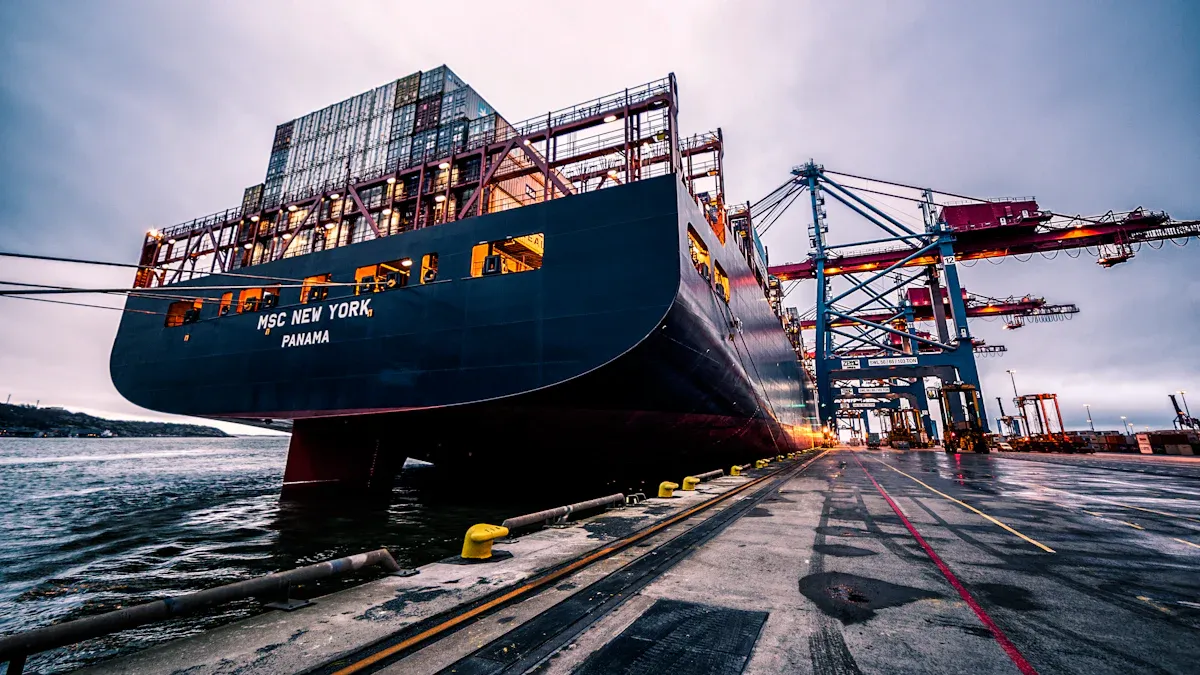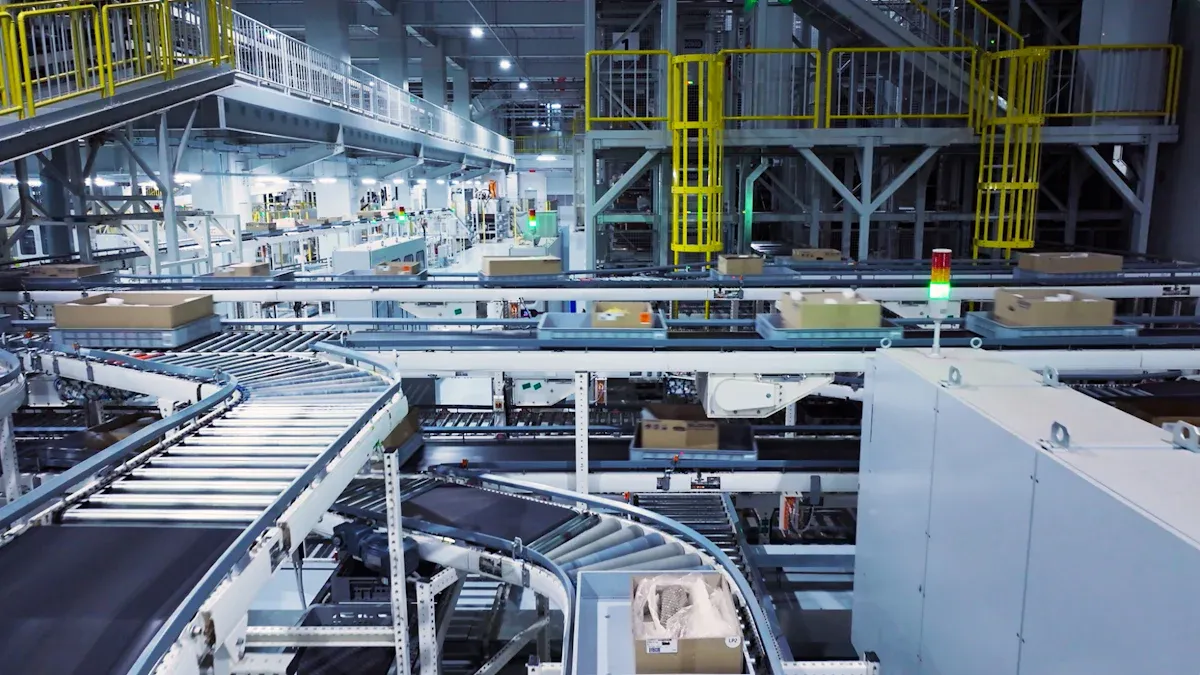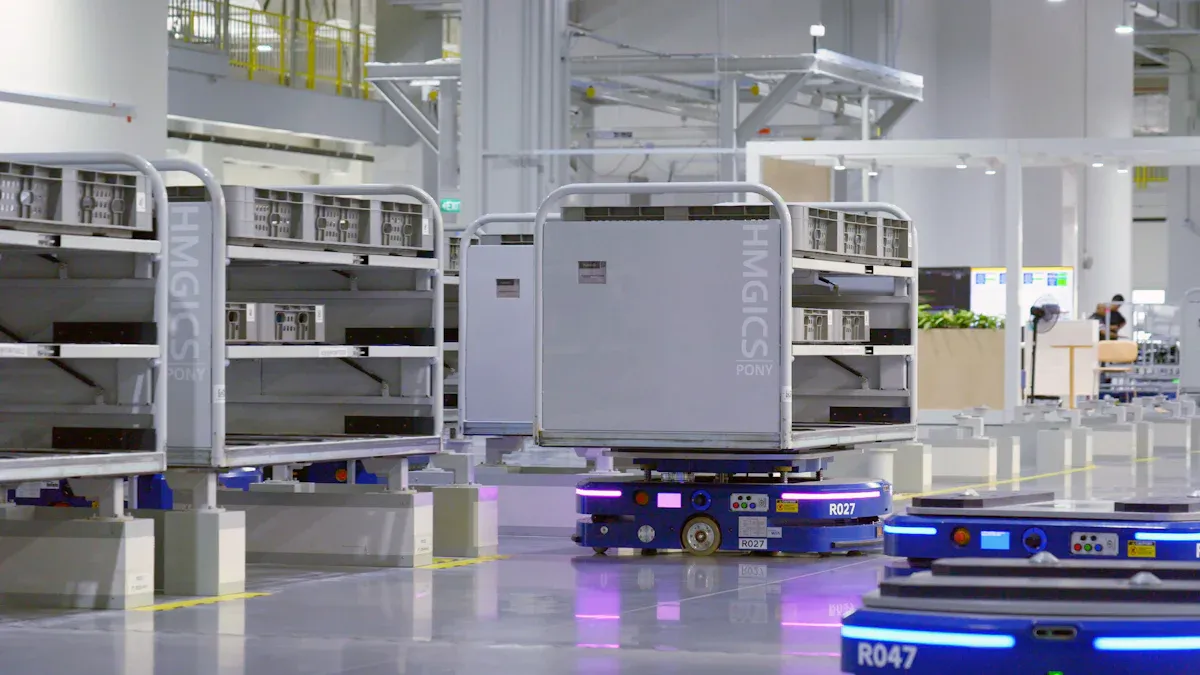Premier global logistics technology upgrades transforming the industry

You see a wave of premier global logistics technology upgrades changing how companies move goods in 2024. Smart tools like AI, automation, and sustainable practices shape the way you work. Many industry leaders focus on cost reduction and better control. In fact, 86% of IT vendors now name cost as a top concern, while 70% stress the need for real-time visibility. You can explore the main upgrades and their direct impact below:
Impact on Logistics | |
|---|---|
AI Integration | Improved demand forecasting and supply chain efficiency |
Automation in Warehousing | Enhanced operational efficiency and reduced costs |
Smart Port Innovations | Optimized port operations and modernized facilities |
Investment in Automated Trucks | Increased freight efficiency |
Focus on Sustainability | Integral to future growth and aligns with environmental awareness |
Staying current with these changes helps you keep your operations efficient and competitive.
Key Takeaways
Embrace AI and machine learning to enhance demand forecasting and optimize supply chain efficiency.
Implement automation and robotics to boost productivity and reduce operational costs in logistics.
Utilize IoT technology for real-time fleet tracking, improving delivery accuracy and customer satisfaction.
Adopt blockchain for secure and transparent transactions, enhancing trust and reducing fraud risks.
Focus on sustainability by optimizing routes and using green technologies to lower emissions and costs.
Premier global logistics technology upgrades

AI and Machine Learning
You see AI and machine learning changing logistics in 2024. These tools help you predict demand, optimize routes, and manage inventory. Companies like PepsiCo and Coca-Cola use AI to forecast demand with fewer errors. Warehouse robots automate picking and packing, which speeds up order processing and lowers costs. AI-powered systems also detect damage and inspect goods, reducing mistakes and improving customer satisfaction. Predictive maintenance helps you avoid machine breakdowns, saving time and money. When you use AI, you can cut operational costs, lower carbon emissions, and improve efficiency. These premier global logistics technology upgrades let you focus on strategic tasks instead of routine work.
Description | Example Companies | |
|---|---|---|
Demand Forecasting | AI-driven forecasting analyzes data to predict demand with reduced error. | PepsiCo, Unilever, Coca-Cola |
Predictive Maintenance | AI anticipates machine failures by monitoring sensor data. | Siemens, GE, Shell |
Warehouse Operations | AI-powered robots enhance efficiency in warehousing tasks. | Berkshire Grey, Covariant |
Route Optimization | AI analyzes factors to determine the most efficient delivery routes. | P&O Ferrymasters, FedEx |
Autonomous Vehicles | AI enables driverless trucks, potentially reducing costs significantly. | Waymo, TuSimple, Embark |
Tip: AI and machine learning help you make faster decisions and reduce waste in your supply chain.
Automation and Robotics
Automation and robotics drive big changes in logistics. You can use automated systems to streamline warehouse operations and reduce manual labor. Businesses that adopt automation see up to a 48% boost in productivity and a 42% drop in operating costs. Autonomous vehicles free up skilled workers’ time, letting them focus on more important tasks. When you increase robotics density by 1%, you gain a 5% efficiency boost. A global retailer improved order fulfillment speed by 25% and cut costs by 30% after using AI-powered warehouse management and mobile robots. These premier global logistics technology upgrades help you handle more orders with fewer errors.
Automation reduces manual processes and improves efficiency.
Robotics increase order accuracy and speed.
Predictive maintenance powered by AI cuts downtime by 20-40%, boosting production by 35%.
IoT and Fleet Tracking
IoT technology gives you real-time visibility into your fleet and shipments. You can track vehicles, monitor fuel levels, and adjust routes based on live traffic data. IoT devices help you prevent spoilage of perishable goods by monitoring temperature. Automated systems record driving hours, making compliance easier and reducing paperwork errors. When you use IoT for fleet tracking, you improve delivery accuracy and customer satisfaction. Tracking precision can improve by 78% with live updates and geofencing. Smarter routing and analytics can lower fuel usage by 30%. These premier global logistics technology upgrades help you save money and deliver goods on time.
Benefit | Description |
|---|---|
Real-time route optimization | GPS tracking with real-time traffic data enables dynamic route adjustments, reducing travel distance and transit times. |
Accurate fuel and battery level monitoring | IoT-enabled systems track consumption patterns, helping reduce overall fuel costs. |
Perishable goods spoilage prevention | Continuous temperature monitoring prevents spoilage of temperature-sensitive products. |
Better inventory visibility | IoT tracking improves asset utilization and reduces time needed to locate equipment. |
Note: IoT solutions help you reduce logistics costs and improve customer experience with accurate ETAs and proactive updates.
Blockchain
Blockchain technology brings transparency and security to logistics. You can track products in real time and access up-to-date information about their location and status. Blockchain creates records that cannot be changed or deleted, which prevents tampering and builds trust. Transactions are verified by multiple parties, reducing fraud risks. Companies like Walmart use blockchain to track food products and improve safety. Nike uses it for better inventory management. Alibaba increases transparency in order tracking, and L'Oréal streamlines international shipments. These premier global logistics technology upgrades help you lower costs, improve speed, and ensure quality.
Evidence Type | Explanation |
|---|---|
Real-Time Tracking | Enables stakeholders to access up-to-date information about product location and status, enhancing visibility and response to issues. |
Immutable Records | Prevents unauthorized tampering, as data cannot be altered or deleted once recorded, ensuring integrity. |
Secure Transactions | Transactions are verified by multiple parties, reducing risks of fraud and building trust among supply chain participants. |
Walmart achieved real-time tracking of food products, enhancing food safety.
Nike improved inventory management through better forecasting and reduced errors.
Alibaba increased transparency in order tracking, addressing fraud challenges.
L'Oréal streamlined international shipments, reducing paperwork and costs.
Cloud Technologies
Cloud technologies help you manage data and collaborate with partners. You can centralize supply chain data, which improves visibility and reduces information silos. Real-time tracking through GPS and IoT devices lets you see delivery statuses and respond quickly to problems. When you use cloud platforms, you make better decisions and keep your supply chain running smoothly. These premier global logistics technology upgrades support teamwork and help you serve customers better.
Tip: Cloud solutions let you access data from anywhere, making your logistics operations more flexible and responsive.
Green Logistics
Green logistics focuses on sustainability and reducing environmental impact. You can adopt electric vehicles and biodiesel fuels to cut greenhouse gas emissions. Route optimization technologies help you save time and fuel. Using biodegradable packaging and reducing waste lowers costs and keeps landfills cleaner. When you optimize delivery routes and consolidate shipments, you use less fuel and reduce carbon emissions. Investing in energy-efficient vehicles leads to long-term savings and fewer emissions. These premier global logistics technology upgrades help you comply with regulations and improve your brand reputation.
Strategy | Impact on Operational Costs | Environmental Outcome |
|---|---|---|
Optimizing route planning | Reduces fuel consumption and travel time | Lowers carbon emissions |
Transitioning to renewable energy | Reduces reliance on fossil fuels | Minimizes environmental impact |
Implementing waste reduction practices | Lowers costs through sustainable packaging and recycling | Reduces waste in landfills |
Investing in energy-efficient vehicles | Leads to long-term cost savings | Reduces greenhouse gas emissions |
Logistics operations contribute 8 to 10% of global carbon emissions.
Lower fuel usage and better load planning can significantly cut operating costs.
Proactive emissions tracking ensures compliance with regulations.
Note: By adopting sustainable practices, you avoid fines and gain a competitive edge while saving money.
Implementation and Impact

Adoption Strategies
You can adopt new logistics technologies by following clear steps. First, assess your current operations to find areas that need improvement. Set specific goals to guide your team. Choose technology that fits your market needs and works with your existing systems. Train your staff and encourage them to embrace change. Build a culture that values innovation and teamwork. Use AI to predict demand and optimize routes. IoT devices help you monitor goods in real time. Blockchain ensures secure and transparent transactions. When you measure results and keep improving, you make technology upgrades successful.
Assess your current situation and set clear objectives.
Adopt technology that meets market demands and integrates easily.
Train and motivate your team to embrace new systems.
Foster innovation and teamwork.
Use AI, IoT, and blockchain for better forecasting, tracking, and security.
Case Studies
Many companies have seen measurable benefits from premier global logistics technology upgrades. Amazon uses advanced algorithms to speed up deliveries and lower transportation costs. Walmart relies on forecasting models to reduce excess inventory by up to 20%. These examples show how technology can improve efficiency and save money.
Company | Technology Implemented | Measurable Benefits |
|---|---|---|
Amazon | Advanced algorithms | Faster delivery times, minimized transportation costs |
Walmart | Sophisticated forecasting models | Reduced excess inventory by up to 20% |
Efficiency and Visibility
You gain better control over your supply chain with technology upgrades. Supply Chain Visibility Technology lets you track shipments and inventory in real time. This reduces delays and helps you allocate resources wisely. IoT devices allow you to monitor goods throughout the supply chain, so you can respond quickly to problems. Cloud-based solutions make it easy to share data with partners, improving teamwork and coordination. When you use these tools, you boost operational efficiency and make smarter decisions.
Metric | Description |
|---|---|
Percentage of orders delivered on time. | |
Order Accuracy | Percentage of correctly picked and packed orders. |
Dock-to-Stock Time | Time from receiving goods to storing them. |
Inventory Management Metrics | Measures inventory levels and order fulfillment speed. |
Cost Efficiency | Cost per unit shipped. |
Workforce Transformation
Your workforce changes as you adopt new technologies. Workers move from manual tasks to managing and training AI systems. Data analysts track AI performance and improve accuracy. Fleet managers oversee AI routing and adjust plans as needed. Warehouse staff supervise robotic pickers and handle exceptions. You can use hands-on training, online courses, and professional certifications to help your team learn new skills. Technology training keeps your staff up to date and boosts productivity.
Workers shift to roles focused on managing AI and robotics.
Data analysts and fleet managers use technology to improve operations.
Training programs include hands-on exercises, continuous learning, and certifications.
Tip: Upskilling your team ensures you get the most from technology upgrades and stay competitive.
Challenges and Solutions
Cost Barriers
You may face high costs when upgrading logistics technology. Expenses include software licenses, hardware, training, and system changes. These costs can slow down your plans. The table below shows the main cost areas:
Cost Area | Description |
|---|---|
Software & Infrastructure Costs | Expenses like software licenses, hardware upgrades, system integration, and maintenance. |
Training & Staffing Expenses | Costs for training programs, hiring IT staff, and managing productivity dips. |
Operational Adjustments | Redesigning processes, data migration, downtime, and updating documentation. |
To manage these costs, you can:
Diversify funding by seeking partnerships or grants.
Use a phased approach to spread out expenses.
Focus on clean, accurate data before starting.
Invest in staff training and plan for system integration.
Tip: Breaking upgrades into smaller steps helps you control spending and reduce risk.
Skill Gaps
New technology requires new skills. Many workers need better technical literacy, problem-solving, and teamwork abilities. You also need people who can operate automated systems and interpret data. The table below highlights common skill gaps:
Skill Gap | Description |
|---|---|
Technical Literacy | Basic technology skills for all roles |
Problem-Solving | Analytical and troubleshooting abilities |
Collaboration | Working with robots and teams |
Continuous Learning | Adapting and learning new skills |
Data Interpretation | Reading and acting on technology data |
You can bridge these gaps by:
Upskilling current employees.
Partnering with IT recruiters.
Hiring contract IT talent for projects.
Encouraging ongoing learning.
Change Management
Change can be hard. Many employees resist new systems because they fear job loss or feel left out. Strong communication and leadership help you overcome this. Involve your team early, explain the benefits, and provide training. Companies that communicate well succeed five times more often with change.
Understand why people resist.
Communicate clearly and often.
Empower employees to take part.
Offer support and training.
Note: Including your team in decisions builds trust and reduces resistance.
Data Security
As you adopt new technology, data security becomes critical. Logistics companies face more cyber threats each year. Attacks like ransomware and DDoS can disrupt your operations and cost millions. Legacy systems are especially vulnerable. You can protect your business by:
Using advanced threat detection tools.
Adopting zero-trust security models.
Training employees to spot risks.
Working with partners to share best practices.
Cybersecurity is now basic business hygiene. Regular training and strong defenses keep your data safe and your business running.
Future Outlook
Emerging Trends
You will see new trends shaping logistics in the coming years. Artificial intelligence continues to grow. You can expect smarter robots and better data analysis. Electric vehicles and renewable energy will become more common. Companies use drones for faster deliveries. You will notice more focus on sustainability and green practices. Blockchain helps you track shipments with greater security. Cloud platforms make teamwork easier. These trends show how premier global logistics technology upgrades keep changing the industry.
AI-powered robots improve warehouse speed.
Electric trucks reduce pollution.
Drones deliver packages quickly.
Blockchain increases trust in supply chains.
Cloud systems support global teamwork.
Ongoing Innovations
You will find many ongoing innovations in logistics. Companies test autonomous ships and trucks. Smart sensors track goods in real time. You can use predictive analytics to plan shipments. Warehouses use robots to sort and pack items. Some businesses use 3D printing to create spare parts on demand. You will see more use of augmented reality for training and repairs.
Innovation | Benefit | Example Use Case |
|---|---|---|
Autonomous Vehicles | Faster, safer deliveries | Self-driving trucks |
Smart Sensors | Real-time tracking | Temperature monitoring |
3D Printing | Quick part replacement | On-demand spare parts |
Augmented Reality | Better training and repairs | Virtual warehouse tours |
Note: You can use these innovations to solve problems and improve your logistics operations.
You see technology upgrades reshaping global logistics in 2024. You gain faster deliveries, better tracking, and smarter planning. Staying proactive helps you stay ahead of competitors. Watch for trends like AI, automation, and green logistics. Keep learning about new tools and methods.
Tip: Explore industry news and training programs to keep your skills sharp and your business ready for change.
Track new innovations.
Invest in workforce training.
Focus on sustainability.
FAQ
What is the biggest benefit of using AI in logistics?
AI helps you predict demand and optimize routes. You save money and reduce mistakes.
Tip: AI lets you focus on important tasks instead of routine work.
How does IoT improve fleet tracking?
IoT devices give you real-time updates on vehicles and shipments. You can monitor temperature, fuel, and location.
Feature | Benefit |
|---|---|
Live Tracking | Accurate ETAs |
Alerts | Prevent spoilage |
Are green logistics upgrades expensive?
You may spend more at first, but you save money over time. Electric vehicles and route planning lower fuel costs.
:seedling: Green upgrades help you meet regulations and improve your brand.
How can you train your team for new technology?
You can use online courses, hands-on workshops, and certifications. Training helps your team learn new skills and stay productive.
Note: Upskilling your staff keeps your business competitive.
See Also
Efficient Project Trucking Solutions by Premier Global Logistics
Accelerate Your Orders with Premier Global Logistics Warehousing
Enhancing Efficiency in LA with Premier Global Logistics Warehousing
